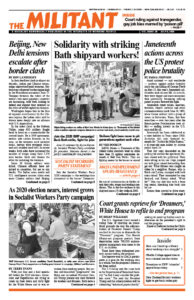The U.S. Supreme Court ruled June 15 that “An employer who fires an individual merely for being gay or transgender defies the law.” This ruling, like their 2015 decision striking down state government restrictions barring gay people from getting married, registers rapidly changing attitudes among working people and others against denial of equal rights.
Since 1964 there have been several proposals in Congress to have sexual orientation and gender added as a protected class like sex or nationality under existing civil rights legislation. Because of the deepening crisis of the capitalist rulers’ two-party system today, all such attempts have failed, despite the far-reaching changes in public sentiment. The court here took it upon itself to relieve the legislature of its responsibility, essentially making new law itself in the guise of a court decision.
In doing so, the majority planted a poison pill in the ruling, mixing sex, sexual orientation and gender together as if they were the same thing.
A 6-3 majority of the court — Donald Trump appointee Neil Gorsuch, Chief Justice John Roberts and the four liberal justices — chose to base the decision on Title VII of the 1964 Civil Rights Act. This outlaws workplace discrimination on the basis of “race, color, religion, sex or national origin.”
Then Gorsuch spends much of the rest of the decision on attempts to justify squeezing “sexual orientation” and “gender” into being a kind of “sex.” He concedes that in 1964, when the law was adopted, the reference to “sex” meant there could be no discrimination against women or men based on their sex. But he brushes that aside.
In a Washington Post op-ed backing the court majority’s argumentation, assistant law professor Daniel Hemel calls Gorsuch’s torturous line of reasoning “technically adroit” and “elegant.”
But the fact is, the court’s way of handling the case assures that years of litigation will follow. Reactionary forces that advance a gender-over-sex agenda will weaken the fight for women’s emancipation. They will seek to use the ruling to demand admittance to women’s bathrooms, sports competitions, locker rooms and other sex-separate spaces, and to attack freedom of speech and health care.
Hailing the court’s reasoning, Devin Michelle Bunten wrote June 23 in the New York Times, “Stop using ‘male’ and ‘female’ to refer to men and women.”
“Women with penises and prominent larynxes,” she said, “use the ladies’ restroom.”
Not based on ‘equal protection’
The court could easily have avoided trying to turn sex into gender, and issued a far clearer and stronger decision by overturning discrimination in hiring and firing based on the 14th Amendment to the Constitution. This mighty product of the victory of the North in the Civil War, the overthrow of slavery, and Radical Reconstruction, says “No state shall make or enforce any law which shall … deny any person within its jurisdiction equal protection of the laws.” That would have made clear that equal protection in hiring and on the job applies to all citizens, with no exceptions or qualifications.
The decision as issued strengthens the hand of those transgender campaigners who argue that sex is a subjective feeling, not an objective fact, and seek to pillory and threaten anyone who says otherwise. It deals a counterrevolutionary blow to the fight for women’s emancipation.
It also weakens the overall fight to end discrimination against gays and lesbians.
In his ruling, Gorsuch admits that the decision will lead to disputes over sex and gender in the future.
The decision now moves to the state level for implementation. Workplace protection for gays and transgender people varies across the country. Sixteen states have no protections, others limit them to public employees. Some protect sexual orientation, but not gender. Others protect both.
Similarities to Roe v Wade
The June 15 decision has striking similarities with the 1973 Roe v. Wade Supreme Court ruling that legalized abortion. That ruling cut short a growing fight by defenders of women’s rights to win legalization of abortion rights based on equal protection. It demobilized the movement for women’s rights and cut short the momentum towards winning overwhelming support to women’s right to choose to have an abortion.
The court majority refused to base Roe v. Wade on the 14th Amendment and its equal protection for women to control their own bodies and health care. Instead, it conditioned legalization on medical criteria, like the age of fetal viability and the need for a doctor’s consent. This opened the door to relentless decadeslong efforts by opponents of women’s rights to chip away at access to abortion. For many women, especially if you live in a rural area, access today is loaded with barriers.
The vast majority of counties in the U.S. have no abortion clinic. Six states have only one. Restrictions are manifold, including waiting times, compulsory counseling about “alternatives,” parental consent and many more. The latest attempt to bar women from being able to obtain an abortion came during the coronavirus outbreak, when some state governments tried to bar them as a “nonessential” medical procedure.
How working people organize to fight to win and defend their rights is crucial. Otherwise these rights are open to ongoing attacks. And, in the case of the June 15 Supreme Court decision, this can open the door to reactionary campaigns to erase the true history of women’s oppression and their ongoing fight for emancipation.

